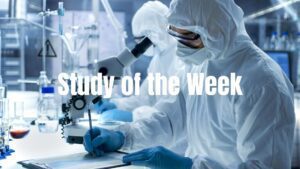Welcome to Study of the Week from Patient Worthy. In this segment, we select a study we posted about from the previous week that we think is of particular interest or importance and go more in-depth. In this story we will talk about the details of the study and explain why it’s important, who will be impacted, and more.
If you read our short form research stories and find yourself wanting to learn more, you’ve come to the right place.
This week’s study is…
Spermidine-mediated hypusination of translation factor EIF5A improves mitochondrial fatty acid oxidation and prevents non-alcoholic steatohepatitis progression
We previously published about this research in a story titled “Could Spermidine Treat Nonalcoholic Steatohepatitis?” which can be found here. The study was originally published in the scientific journal Nature Communications. You can read the full text of the study here.
This research team was affiliated with the Duke-NUS Medical School.
What Happened?
Non-alcoholic fatty liver disease (NAFLD) is far from a rare disease. In fact, it’s quite common and rates are increasing. About 25 percent of adult humans are believed to have it. An advanced form of NAFLD, called nonalcoholic steatohepatitis (NASH), is not as common, but rates for this form are also increasing. Unfortunately, pharmacological therapies for the disease are limited in effectiveness. A greater understanding of the disease mechanism is needed in order to help develop more effective treatments.
This study sought to understand the molecular mechanisms behind nonalcoholic steatohepatitis and in so doing identify an as yet untested method of treatment. The team looked at certain liver enzymes associated with a specific pathway and compared them in healthy people and people with the disease. They then continued the research using a preclinical nonalcoholic steatohepatitis disease model.
The disease disrupts a molecular pathway by reducing the enzyme deoxyhypusine hydroxylase; the enzyme is responsible for attaching hypusine residue from spermidine onto a protein which translates RNA genetic code. This protein is called EIF5A. The disruption results in decreased mitochondrial activity and synthesis of proteins for them. It also causes a reduction in fatty acid metabolism. Mitochondria are critical for the generation of energy within a cell.
The scientists added spermidine to the preclinical model and cell cultures. It caused an improvement in mitochondria activity and in fatty acid metabolism. Meanwhile, the characteristic scarring and inflammation found in nonalcoholic steatohepatitis was reduced. In effect, spermidine was able to reverse the disruption in the pathway caused by the disease. This gives the team a therapeutic target and a potential treatment to continue studying…and hope for people living with the disease.
About Nonalcoholic Steatohepatitis
Nonalcoholic steatohepatitis (NASH) is a type of liver disease in which fat is deposited in the liver independent of excessive alcohol consumption. This disease can progress rapidly. Risk factors include metabolic syndrome and insulin resistance. There also appears to be some genetic component to the disease as well. This condition also increases the risk of other health problems and liver cancer. Men also seem to be at greater risk, getting the disease as almost twice the rate that women do. Symptoms of nonalcoholic steatohepatitis include jaundice, malaise, fatigue, and abdominal pain or discomfort. Without treatment, the liver can become scarred, and the patient may need a liver transplant. However, the condition can also be managed with proper diet, the use of certain medications, and exercise. To learn more about nonalcoholic steatohepatitis, click here.
Why Does it Matter?
Since cases of nonalcoholic steatohepatitis are likely to continue to increase around the world, finding more effective methods of treatment is going to become an urgent issue of public health. The discoveries made in this research have the potential to be critical steps forward in developing more effective medical interventions for the disease.
“Our findings that the dysregulation of mitochondrial protein synthesis can be rescued by spermidine provides novel mechanistic insights, a therapeutic target, and potential prevention agent for managing non-alcoholic fatty liver disease.” – Professor Paul Michael Yen, Senior Author, Professor, Cardiovascular & Metabolic Disorders Program, Duke-NUS School
There is still a ways to go before the findings from this study will translate directly into an effective treatment for nonalcoholic steatohepatitis, but there’s no doubt that these insights will give researchers a lot more direction when it comes to tackling this disease.
“Currently, there is no pharmacological therapy for NASH, with several drugs showing only limited efficacy in clinical trials, so there is an urgent need to better understand the molecular mechanisms that underlie it.” – Dr. Zhou Jin, First Author, Senior Research Fellow, Cardiovascular & Metabolic Disorders Program, Duke-NUS Medical School
Next steps in this research include further study if the molecular pathway to get a better idea of its role in synthesizing proteins. This will include research into the impacts of age, gender, and the severity of disease on the pathway. This could help researchers determine which patients would most likely benefit from spermidine.



